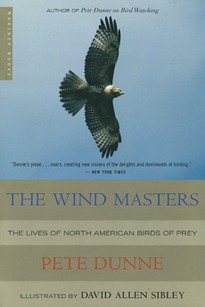Reviewed by Grant McCreary on July 3rd, 2008.
I first encountered this title while browsing the shelves at the bookstore where I became a birder (full story). After reading the back cover, and leafing through the book, I was decidedly uninterested. Why? It appeared that the accounts were told from the bird’s point of view, and even included inner dialogue. I’ve got nothing against anthropomorphism in general, but this seemed a bit much. I wanted to learn about the birds, not read stories in which they are characters. Now, almost five years hence, I have finally read the book, and I have no problem admitting that I had been wrong.
There are 33 accounts here, one for each of the diurnal raptors that breed in the United States and Canada (including the vultures). Each averages 7-8 pages. They are not exhaustive in their treatment of each bird, but are rather vignettes into their lives. One deals primarily with courtship, while others focus on feeding, migration, or some other aspect. However, Dunne is still able to include a surprising amount of information about each species in its given chapter.
The accounts are presented not in taxonomic order, but in chronological order based upon the time of year the story takes place, starting in winter and proceeding through spring, summer, and fall. Thus, even though each chapter deals primarily with a specific portion of the bird’s life, the book as a whole presents a complete overview of a generic raptor’s year.
I had not been wrong about the form of the accounts. They are indeed fictional stories in which the birds can have thoughts, dreams, and even a kind of dialogue. However, the author uses various techniques so that each account is different. Here are a few examples:
- Dunne’s Black Vulture thinks and hisses to itself (yes, hisses, since New World vultures lack a syrinx and thus can’t really vocalize) during its morning routine. But scattered within the description of the bird’s morning, the author discusses such topics as taxonomy, convergent evolution, and genetics.
- The White-tailed Kite is arguably not even the primary character of its account. Instead, it’s a man stuck in a California traffic jam, where the kite is in the periphery, foraging along the interstate. Human characters are found in several of the stories, and the reader may at first wonder why. The author deftly creates parallels in the situation of the bird and person. The reader is then better able to identify with the raptor, since aspects of its life have also been framed in human terms.
- Dunne does not give his Swallow-tailed Kite thoughts or a voice. This chapter reads like a tribute, or even a prose-disguised ode, to the bird. It is perhaps the best such tribute that I have read.
In his introduction, Dunne states that he used fictional stories because “hard information…is often more easily assimilated when it is presented obliquely.” In the hands of a lesser writer, the result could have been awful, but Dunne succeeds masterfully. These accounts are simultaneously informative and interesting, educational and entertaining. They have been written in his usual, inimitable style, which should be immediately familiar to anyone who’s read much of his work (and if you haven’t, then you really should. Check out this list of his works, including some online columns you can read for free.).
As a nice bonus, two black-and-white drawings by David Sibley are included for each account. There is a portrait of each bird’s head, as well as a full page depiction of an event or situation from the text. Sibley, whose name is now synonymous with his field guide, is a fantastic artist, and his work here is as good as one would expect. They add much to the book and are a welcome inclusion.
Recommendation
Anyone with even a remote interest in birds of prey should read this book. There are plenty of books that will assist you in identifying raptors, and others where you can learn about their lives. But after reading this book, you will feel like you know these majestic birds, and you will not look at them in the same way again.
Disclosure: I get a small commission for purchases made through links in this post.



Comment